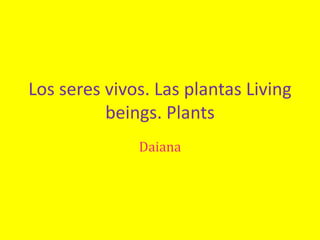
Daiana
- 1. Los seres vivos. Las plantas Living beings. Plants Daiana
- 2. Las características de los seres vivos Nos nutrimos. Los seres vivos necesitamos unas sustancias, llamadas nutrientes, para crecer y obtener energía. Nos relacionamos. Los seres vivos notamos lo que sucede en el medio y reaccionamos ante ello. Nos reproducimos. Los seres vivos podemos producir descendientes parecidos a nosotros.
- 3. The characteristics of living things Wenurture. Living things need a call suntancias nutrients to grow and get energy. We relate. Living things we notice what happens in the middle and it will react to an. We reproduce. Living beings can produce offspring like us.
- 5. La organización de los seres vivos Tejidos. Son conjuntos de células similares, especializadas en realizar cierta función. Por ejemplo: el tejido muscular está formador por células espsecializadas en producir movimientos. Órganos. Son partes del organismo formadas por varios tejidos y que realizan una función concreta. Por ejemplo: el corazón bombea sangre. Sitemas y aparatos. Son conjuntos de órganos, cada uno de los cuales lleva a cabo una parte de un proceso más complejo. Por ejemplo,los órganos del aparato digestivo realizan las distintas tareas que forman parte del proceso de la difestón.
- 6. The organization of living beings Tissues. Are sets of similar cells specialized in performing a certain function Organs. Parts of the body are composed of multiple tissues and perform a specific function. Systems and equipment. Are sets of organs, each of which performs a part of acomplexprocessmore.
- 8. Clasificamos los seres vivos Los seres vivos se pueden clasficar en cinco reinos: moneras, protoctistas, hongos, plantas y animales.
- 9. Living beings can be classified into five kingdoms: Moneasa, proctistas, fungi, plants The living sers can be classified into five kingdoms: Monera, protoctists, fung and plnts and animls.
- 11. Las plantas La raíz. Fija la planta al tereno y absorbe agua y minerales. El tallo. Sostiene las hojas. Tiene unos conductos por los que circulan el agua, por los minerales, los nutrientes,etc. Las hojas. En ellas, la planta fabrica nutrientes.
- 12. Plants The root. Set the plant to the ground and absorbs water and minerals. The stem. Holds leaves. Has pr ducts that circulate the water, the plant produces nutrients. Leaves. In them, the plant produces nutrients.
- 14. La nutrición en las plantas La raíz absorbe agua y minerales La raíz, atrvés de sus pelos radicales, abosrbe agua y minerales.
- 15. Nutrition in plants. The root water and minerals abosrbe The root, through their root hairs, absorb water and minerals from the soil.